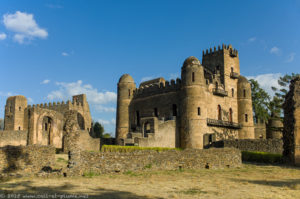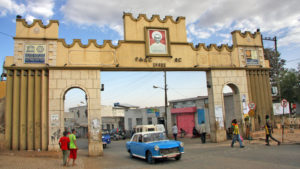Gondar
 Gonder was the 17th Century capital of Ethiopia and is notable for its medieval castles and churches. The City’s unique imperial compound contains a number of castles built between 1632 and 1855 by the various emperors who reigned during this period. These dramatic castles, unlike others in Africa, display richness in architecture that reveals the Axumite traditions as well as the influence of Arabia.
Gonder was the 17th Century capital of Ethiopia and is notable for its medieval castles and churches. The City’s unique imperial compound contains a number of castles built between 1632 and 1855 by the various emperors who reigned during this period. These dramatic castles, unlike others in Africa, display richness in architecture that reveals the Axumite traditions as well as the influence of Arabia.
Other treasures of Gonder include the 18th century palace of Ras Beit, the bath of Fasilades, the ruined palace of Kusquam, and the church of Debre Berhane Selassie with its unique murals.
Lalibela
 The legend says that angels helped build the churches which were built at great speed and seem to be of superhuman creation in scale, workmanship and concept.
The legend says that angels helped build the churches which were built at great speed and seem to be of superhuman creation in scale, workmanship and concept.
Queen Gudit was born in Lasta (Agew region) near Lalibela. Her father was a Felasha (Beta Israel or Jewish) king called Gideon. It is said that at that time the Felashas refused to pay taxes to the Axumite kingdom and the king of Axum sent troops to the Felasha regions and forced them to pay taxes. The Axumites raids frustrated the Felashas. In tenth century, Queen Gudit united the Felashas, and marched on Axum to try to remove Christianity and the Axumite dynasty from Ethiopia once and for all. She destroyed Axum, overthrew and killed the King and Princes ending the Axumite kingdom. This led to the rise of the “Zagwe Dynasty”. Queen Gudit is remembered as evil and a destroyer of churches. This period of history is known in Ethiopian tradition as “end of the first millennium”.
Following Queen Gudit’s campaign against Axum, Marara Teklehaimanot formally founded the “Zagwe Dynasty” in 1137. He became the first Zagwe King and ruled from Lasta. In 1270, the Zagwe Dynasty ended and Yekuno Amlak took the throne and restored the “Solomonic Dynasty”.
Lalibela stands on soft red volcanic rock and was originally known as Roha. It was later renamed Lalibela when King Lalibela was credited with building the rock-hewn churches there in the twelfth century. Lalibela is now regarded as one of the greatest Ethiopian architectural wonders and is ranked the eighth most incredible historical site in the world by UNESCO. Axum and Lalibela have in common architectural and stone works, which illustrate Ethiopian civilisation at great length.
In Lalibela there are 11 churches cut out of solid red volcanic rock, which are constructed to represent Jerusalem. The churches are divided into Northern and Eastern groups of churches by a rock-cut channel (river) called Yordannos (Jordan River) and connected by narrow and deep passages. Bieta Medhane Alem is the largest and most impressive monolithic church. Of all the churches, Bieta Giyorgis (Saint George) is particularly stunning and beautiful, situated apart from the other churches to the west, intricately carved into the shape of a cross. All the churches are still used as places of worship.
Harar
 Harar was established by Sultan Abu Beker Mohammed in 1520. Harar, the Holy City of Ethiopia’s Muslim community, is believed to be the forth-holiest city after Mecca, Medina and Jerusalem. The old City Wall of Harar is the main attraction and symbol of Islamic architecture. Harar has approximately 90 mosques, which form the largest concentration of mosques in the world. One of Harar’s main attractions is the hyena man who feeds hyenas on the outskirts of the town every night.
Harar was established by Sultan Abu Beker Mohammed in 1520. Harar, the Holy City of Ethiopia’s Muslim community, is believed to be the forth-holiest city after Mecca, Medina and Jerusalem. The old City Wall of Harar is the main attraction and symbol of Islamic architecture. Harar has approximately 90 mosques, which form the largest concentration of mosques in the world. One of Harar’s main attractions is the hyena man who feeds hyenas on the outskirts of the town every night.
Harar is known for its turmoil and bloodshed. Ahmed Gragn killed Abu Beker Mohammed who was the ruler of Harar. Ahmed Gragn was a militant Muslim leader and used Harar as his base to launch his jihad and raids against the Ethiopian Christian Empire in 1528. He destroyed many churches and threatened the complete distruction of Ethiopian Christendom. He was killed by Emperor Gelawdewos in a Battle near Lake Tana in 1543. The raids continued against the Christians led by Ahmed Gragn’s widow Bati Del Wambara. In 1559, Emperor Gelawdewos marched on Harar with the aim to eradicate the constant religious sectarianism taking place. Gelawdewos was killed in a battle and his head was paraded around the city on a stake.
In 1647, Emir Ali ibn Daud took control the city and established an autonomous administration. Despite the continuous fighting with Oromo tribes, Harar expanded; it became well populated, an important city for trade and a centre of Muslim scholarship. It issued its own currency. After 250 years of autonomous rule, Egypt occupied Harar and killed the Emir in 1875. The Egyptian action created a strong resistance in the Muslim community of Harar. Emir Abdullah took control and led a campaign against the Egyptians, which ended in 1885.
In 1887, Harar lost its autonomy when Menelik, Prince of Shewa, who later became Emperor of Ethiopia in 1889, waged war against the army of Emir Abdullah. Menelik defeated the Emir at the Battle of Chelenko in 1887. Menelik then established a new administration, including several members of the emir’s family to prevent renewed religious sectarianism, headed by Ras Mekonnen, the father of Emperor Haile Selassie.
Harar then began to disintegrate and lost its status as a trade centre in the end of nineteenth century when the railway line was built between Addis Ababa and Djibouti through Dire Dawa. From 1902, Dire Dawa became the main commercial centre of Ethiopia.
However, Harar remained as the spiritual City of Ethiopia’s Muslim community, the political capital of Hararge Province until 1994 and has become a federal city-state since 1995.
Contact Us & Book Your Tour Now